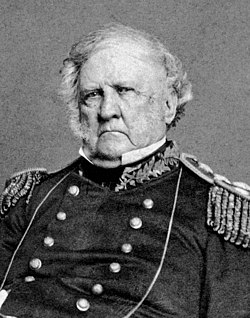| Commanding General of the United States Army | |
|---|---|
| United States Army United States Department of War | |
| Type | Senior-most officer |
| Reports to | The secretary of war |
| Seat | Several HQs (Washington) |
| Appointer | The president with Congress advice and consent |
| Term length | No fixed term |
| Constituting instrument | An act of the Second Continental Congress |
| Formation | 15 June 1775 June 1821 |
| First holder | GEN George Washington as Commander-in-Chief of the Continental Army MG Jacob Brown as Commanding General of the United States Army |
| Final holder | LTG Nelson A. Miles |
| Abolished | 8 August 1903 |
| Succession | Chief of Staff of the Army |
Commanding General of the United States Army was the title given to the service chief and highest-ranking officer of the United States Army (and its predecessor the Continental Army), prior to the establishment of the Chief of Staff of the United States Army in 1903. During the American Revolutionary War (1775–1783), the title was Commander-in-Chief of the Continental Army. In 1783, the title was simplified to Senior Officer of the United States Army. In 1821, the title was changed to Commanding General of the United States Army. The office was often referred to by various other titles, such as "Major General Commanding the Army" or "General-in-Chief".
Contents
- Officeholders
- Commander-in-Chief of the Continental Army (1775–1783)
- Senior Officer of the United States Army (1783–1821)
- Commanding General of the United States Army (1821–1903)
- Timeline
- See also
- Notes
- Bibliography
- References
From 1789 until its abolition in 1903, the position of commanding general was legally subordinate to the United States Secretary of War; (senior member of the President's Cabinet), but was replaced by the creation of the statutory Chief of Staff of the Army by action of the United States Congress in 1903, under the 26th President Theodore Roosevelt (1901–1909).






















